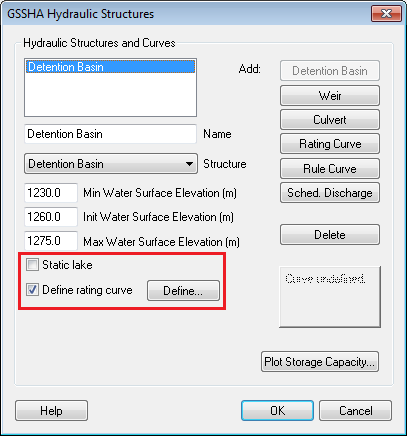WMS:GSSHA Lakes and Wetlands: Difference between revisions
No edit summary |
|||
| Line 49: | Line 49: | ||
[[Category:GSSHA|L]] | [[Category:GSSHA|L]] | ||
[[Category:GSSHA Dialogs]] | [[Category:GSSHA Dialogs|Lake]] | ||
Revision as of 15:06, 26 August 2016
Defining Wetlands and Lakes
Wetlands can be created as feature polygons in a GSSHA coverage. Lakes and detention basins should be defined at a point by defining a detention basin hydraulic structure at a point attribute on a stream in a GSSHA coverage.
Follow these additional steps after assigning a detention basin as a node attribute in a GSSHA coverage:
- Create an embankment arc downstream from the lake that represents the dam elevation for the lake. Make sure the type of arc is set to be an embankment arc and that the elevations of the arc are set in the embankment arc editor. When creating the embankment arc, the grid edges defined by the embankment arc must be downstream from the outlet point/detention basin hydraulic structure. If the edges are not downstream from the outlet (display the edges to make sure they are outside), an error will appear after defining the lake water surface elevations.
- Go to the detention basin node hydraulic structure attributes and set the minimum water surface elevation, initial water surface elevation, and maximum water surface elevation in the GSSHA Hydraulic Structures dialog.
- Define any outlet structures, such as culverts, weirs, rating curves, scheduled discharges or rule curves, for this feature node with the detention basin attributes.
Static Lakes
One option of note is the static lake option. Lakes can be specified as static features on the overland and channel. This can be computationally expedient because the calculations required for lakes taking and releasing overland cells and channel nodes is removed. The lake is assumed to occupy the maximum lake extent specified. To make a lake static, turn on the Static lake option in the GSSHA Hydraulic Structures dialog. The Min/Max/Init WSE must still be specified. All cells below the Max WSE become lake cells and any water that enters the cell through any mechanism will be added to the lake. If the lake area is actually highly variable, then the accuracy of this approximation may suffer.
Lake Rating Curves
A lake rating curve option is available. A stage/volume/area curve can be specified for a lake by toggling the Define rating curve option and defining the curve. The rating curve stage values must go up to at least the Max WSE.
Rating curves can be used with or without the Static Lake option turned on.
If the lake rating curve is specified, the lake stage/area/volume calculations will be performed using the rating curve. The lake will still interact with the stream and the overland based on the stage of the lake unless the Static lake option is toggled on.
Wetlands
Wetland areas store small amounts of water and act as important aquifer recharge areas. The areal parameters are assumed to be homogenous over the polygon. Currently, the wetlands areas will act as small lakes with slightly different infiltration parameters. A different hydraulic conductivity value can be specified for the sediments responsible for the wetland condition if a high water table is not the principle cause of the wetlands. Currently the wetlands and lakes do not have any special sediment trapping or contaminant removal parameters. They are simple treated as modifying the stream and overland flow processes. Lakes and wetlands may be in-stream or out-of-stream features.
Lakes and Wetlands in GSSHA
Lakes and wetlands must be used in conjunction with a rating curve (or other curve or hydraulic structure, if applicable) at the outlet to describe how they release the stored water. The rating curve is set up as a hydraulic structure at the outlet node of the lake or wetland.
The wetland areas are treated as simple flow storage areas with special sediment conditions. The wetland sediments are treated as a lens that must be saturated before it will release water into the groundwater domain. Thus five parameters must be specified for the wetlands area. These are the maximum storage depth, the retention depth (sediment lens thickness), the base elevation, the hydraulic conductivity of the sediment lens, and the hydraulic conductivity of the soil just below the sediment lens (retention depth).
Related Topics:
GSSHA | |
|---|---|
| XMS Wiki Links | Calibration (Automated • Manual • Output) • Channel Routing • Contaminants • Digital Dams • Embankment Arcs • Feature Objects (Arcs • Nodes • Polygons) • File Types • Groundwater • Groups • Hydraulic Structures • Job Control • Join SSURGO Data • Mapping Tables • Maps • Menu • Model Linkage • Multiple Simulations • Nutrients • Observations • Output Control • Overland Soil Erosion • Pipe and Node Parameters • Precipitation • Radar Rainfall • Save GSSHA Project File • Smooth GSSHA Streams • Snowmelt • Solution (Analysis • Data) |
| Related Tools | MWBM Wizard • Using Soil Type Data with GSSHA |
| GSSHA Wiki External Links | GSSHA Wiki: Overview • Primer • User's Manual • Tutorials |
